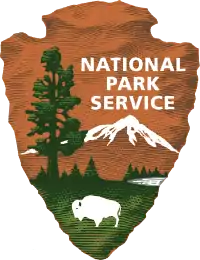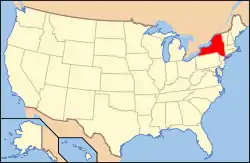Saratoga Spa State Park
Saratoga Spa State Park is a 2,379-acre (9.63 km2) state park located in Saratoga County, New York in the United States.[3] The park is in the City of Saratoga Springs, near US 9 and NY 50.
Saratoga Spa State Park | |
 The Hall of Springs, 2008 | |
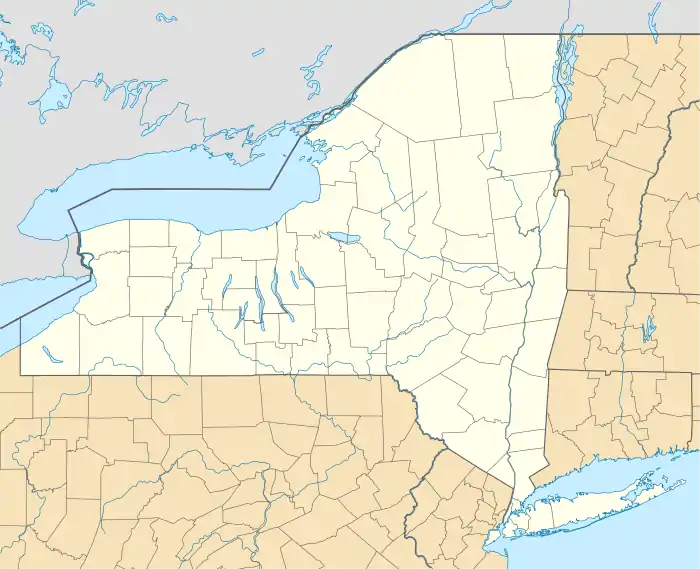  | |
| Location | Saratoga Springs, New York, Town of Milton, New York, Town of Malta, New York |
|---|---|
| Coordinates | 43°3′4″N 73°48′14″W |
| Built | 1835 |
| Architectural style | Colonial Revival, Beaux Arts |
| NRHP reference No. | 85002357 |
| Significant dates | |
| Added to NRHP | September 12, 1985[1] |
| Designated NHL | February 27, 1987[2] |
The grounds contain mineral springs, classical bath and spa houses, and the Saratoga Performing Arts Center.
History
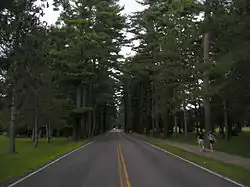
The area, part of which became the park, drew interest from Mohawk and Iroquois Native American tribes for its hunting and mineral springs. The Native American name for the area was Kayaderosseras.[4] The first recorded use of the springs was by Sir William Johnson during the French and Indian War, who was brought to Saratoga to recover from wounds.
In the 19th century, the area became much visited for its purported medicinal effects. Entrepreneurs dug wells and bottled the mineral water for sale and gas companies sold the carbonation to soda fountains.[5] In 1907, the stage was set to protect the springs in a lawsuit Frank Hathorn vs. Dr. Strong's Sanitarium, which showed that pumping on one well decreased the flow of water in wells across the city. The court certified the relationship between wells and when Dr. Strong stopped pumping, the flow of water in Mr. Hathorn's well resumed its natural flow. In 1908, as the springs were being depleted, the New York Assembly passed an injunction against pumping water; however the injunction was ignored. In 1909, governor Charles Evans Hughes signed into law a bill that made the springs of Saratoga a state reservation.[6]
In the 1930s, Reconstruction Finance Corporation funds were used to develop bath houses, research facilities and a drink hall. The Saratoga Reservation was designed with graded walkways intended to help rehabilitate those with heart conditions. After World War II veterans were welcomed as part of their readjustment and Holocaust survivors began using the baths as part of their healing process.
The spa was named a state park in 1962. It was declared a National Historic Landmark in 1987, for its natural and architectural features, and for its role as the subject of early conservation measures.[2][7]
In 2007, it was confirmed by state officials that the reportedly "pure" mineral water used in the public baths at the state park was actually mixed with tap water from a nearby source.[8]
Park features
Springs


The Saratoga Springs area has the only active spouting geysers east of the Mississippi River in the United States. The mineral springs for which the area is famous arise from fissures in the Saratoga Fault, which runs 65 miles (105 km) from Whitehall to Albany. The carbonated water that vents in springs and geysers is rich in minerals and salts.
Two of the most visited springs today are Geyser Island Spouter and Orenda Spring, along Geyser Creek. Geyser Island Spouter, which sends a narrow plume of water 10 to 15 feet (3 to 5 m) into the air, first emerged in the early 1900s. Since that time, it has deposited minerals that grow a tufa deposit at the rate of two inches (5 cm) per year. Orenda Spring has created a massive tufa dome, which continues to fossilize leaves and other debris as it grows.
Springs in operation
- Hathorne
- Orenda
- Hayes
- Charlie
- Geyser Island
- State Seal
- Polaris
- Lincoln (Baths)
- Shonts
- Tallulah
- Karista
Venues and museums
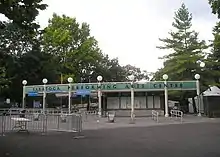
The park hosts theater and other events. The Saratoga Performing Arts Center, located on the state park grounds, has been the summer home of the Philadelphia Orchestra and New York City Ballet since 1966. The SPAC Amphitheater is 110 feet (34 m) high, sits in a natural, curved bowl bordered by large pine trees. The amphitheater has seating for 5,100 and the lawn can hold an additional 25,000 people.
The park contains the Spa Little Theater, which hosts plays throughout the year. The Spa Little Theater is located on the north side of the park office.
The park is also home to the National Museum of Dance and Hall of Fame, the Saratoga Automobile Museum, the Lincoln Mineral Baths and Spa, and the Gideon Putnam Resort & Spa.
Recreation
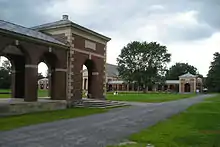
Saratoga Spa State Park offers a variety of recreational opportunities, some of which require small admission fees.
several pools are available at the park. The "Peerless Pool" is a complex of three pools, including a children's pool, water slides, and a zero depth entry Olympic-sized swimming pool. The "Victoria Pool" is a smaller pool located near the golf course and surrounded by covered arcades. It was built when the original park buildings were constructed. The bath house was on the north end and the golf house was on the south end. Today the former golf house has been converted to a restaurant.
The park also has tennis courts, two golf courses, picnic areas, horseshoe pits, softball fields, and volleyball courts. Several picnic pavilions are equipped with electricity and all are near restrooms.
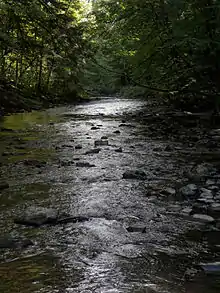
A stretch of Geyser Creek is located in the park and offers opportunities for fishing. Trails for hiking and snowshoeing are also found within the park. The park hosts ice skating in the winter and interpretive programs throughout the year. It also hosts the annual New York State Section 2 Cross Country Championships.
See also
References
- "National Register Information System". National Register of Historic Places. National Park Service. January 23, 2007.
- "Saratoga Spa State Park". National Historic Landmark summary listing. National Park Service. 2007-09-19. Archived from the original on 2012-04-12.
- "Section O: Environmental Conservation and Recreation, Table O-9". 2014 New York State Statistical Yearbook (PDF). The Nelson A. Rockefeller Institute of Government. 2014. p. 674. Archived from the original (PDF) on September 16, 2015. Retrieved February 13, 2016.
- Beauchamp, William Martin (1907). Aboriginal Place Names of New York (New York State Museum Bulletin, Volume 108). New York State Education Department. p. 71. Retrieved February 13, 2015.
- Murphy, Ed (1977). "The Politics of Hydrotherapy, and the Development of a New York State Policy".
a collection of local histories available through the Saratoga Springs Public Library's Saratoga Room
- Natural Heritage Trust; New York State Office of Parks, Recreation and Historic Preservation; New York State Council of Parks & Recreation (1975). Fifty Years: New York State Parks, 1924-1974. Natural Heritage Trust. p. 11.
- Breyer, Lucy A. (July 1985). "Saratoga Spa State Park". National Register of Historic Places Inventory - Nomination. National Park Service. See also Accompanying photo
- "N.Y. mineral water spa mixed with tap". Yahoo! News. March 19, 2007. Archived from the original on March 22, 2007. Retrieved May 31, 2015.CS1 maint: unfit URL (link)
External links
| Wikimedia Commons has media related to Saratoga Spa State Park. |
- Saratoga Performing Arts Center
- National Museum of Dance & Hall of Fame
- Saratoga Automobile Museum
- Historic American Buildings Survey (HABS) No. NY-6341, "Patrick House, Spa State Park", 27 photos, 17 data pages, 4 photo caption pages
